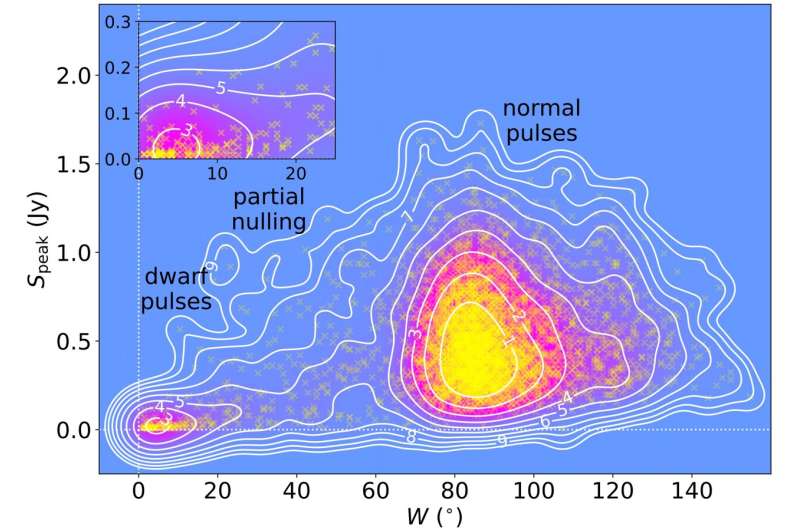This article has been reviewed according to Science X's editorial process and policies. Editors have highlighted the following attributes while ensuring the content's credibility:
fact-checked
peer-reviewed publication
trusted source
proofread
Scientists use FAST to discover a new population of 'dwarf' pulses

Using the Five-hundred-meter Aperture Spherical radio Telescope (FAST), a research team led by Prof. Han Jinlin from the National Astronomical Observatories of the Chinese Academy of Sciences (NAOC) has detected distinct "dwarf pulses" from a bright pulsar PSR B2111+46, studied the radio emission in unprecedented detail and probed the unknown physics in the magnetosphere.
This study was published in Nature Astronomy.
Pulsars generally emit periodic radio signals. However, some old pulsars occasionally quench for some periods, a phenomenon known as "pulse nulling." Perhaps the particles cannot be produced in the magnetosphere due to improper conditions or changes in the magnetic field structure and radiation region, or the area for particle creation is then flooded by plasma produced in other areas.
The exact reason for the absence of pulsar radiation is a mystery because it is impossible to probe the physical state of the pulsar's magnetosphere when radiation is quenched.
PSR B2111+46 is a relatively old pulsar, and scientists have long known that that emission from this pulsar often nulls for periods of time. However, dozens of unusually weak, very narrow pulses—previously unobserved—were detected during ordinary nulling periods when it was serendipitously observed on Aug. 24, Aug. 26 and Sept. 17, 2020, as part of the Galactic Plane Pulsar Snapshot survey, a key project of the FAST to hunt pulsars.

To verify this new kind of emission state, the researchers observed this pulsar for two hours again on March 8, 2022. "Finally, we picked out 175 such narrow, weak pulses," said Dr. Chen Xue, the first author of the study. According to Dr. Chen, such pulses stand out from normal pulses in terms of pulse width and energy, and thus have been named "dwarf pulses."
Whereas normal individual pulses emit radiation through a "thunderstorm" of particles produced by copious discharges in regularly formed gaps near the pulsar's magnetic poles, dwarf pulses are produced by one or a few "raindrops" of particles generated by pair production in a fragile gap of this near-death pulsar.
These sporadic, weak, and narrow pulses constitute a new radiation state independent of normal pulses, and such pulses often exhibit a rare reversed spectrum, i.e., they have much stronger emission at higher radio frequencies, something that is very rarely detected in such a distinguished timescale from astronomical sources. "The properties of such dwarf pulses would be hard to be measured by other radio telescopes than FAST," said Prof. Han, "and measurements of such a new population of dwarf pulses reveal that the magnetic field structure for the pulsar radiation remains unchanged even when the radiation is almost ceased."
"In fact, a smaller number of dwarf pulses have also been detected from a few other pulsars," said Yan Yi, co-first author of the study. "Detailed studies of such a dwarf pulse population could uncover some mysteries of unknown pulsar radiation processing and reveal the extreme plasma state in the pulsar magnetosphere."
More information: Yan Yi et al, Strong and weak pulsar radio emission due to thunderstorms and raindrops of particles in the magnetosphere, Nature Astronomy (2023). DOI: 10.1038/s41550-023-02056-z. www.nature.com/articles/s41550-023-02056-z
Journal information: Nature Astronomy
Provided by Chinese Academy of Sciences





















